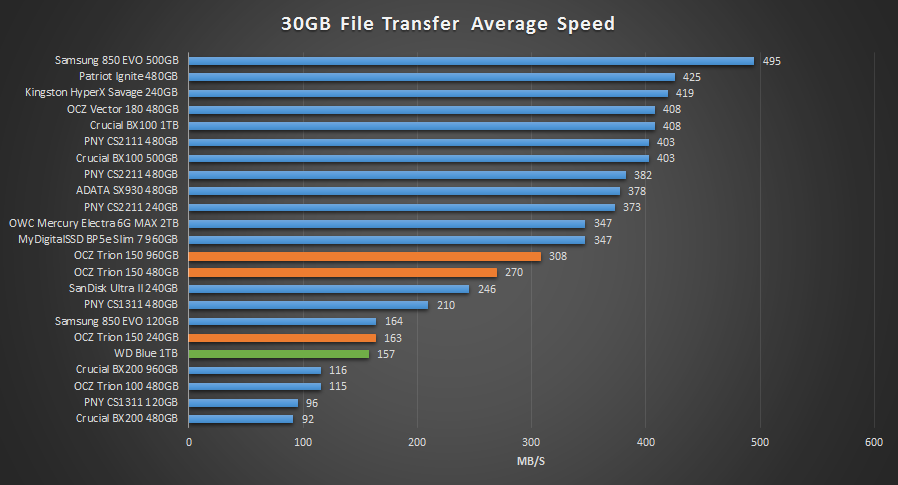REAL WORLD FILE TRANSFER
Finally, we wanted to see how performance was in a real world use when transferring large files to the SSDs. As we know, most TLC NAND based SSDs utilize a SLC caching algorithm to help improve performance, especially writes. This is needed due to the inherent slowness of TLC NAND. For this test we are going to simply stress write performance by transferring over a 30GB folder of movies off of one SSD to this one and time how long it takes. Once complete we can calculate the average speed.

Instantly we can see that the OCZ Trion 150 delivers better write performance than that of the Crucial BX200 series and PNY CS1311.Comparing the results of the 480GB model we can see that it was able to deliver an average transfer speed of 270MB/s, which is much than the Trion 100’s 115MB/s average. OCZ’s claim therefore holds true, during file transfers we will see a 50% improvement over the Trion 100. The 960GB did well reaching 308MB/s average, but not quite as good as the MyDigitalSSD BP5e, which averaged 40MB/s more during this test.
POWER CONSUMPTION
For our power consumption testing, we have the drive connected to the system as a secondary drive. To record the wattage, we are now utilizing a Quarch Technology Programmable Power Module. It allows us to accurately measure power consumption over time and is flexible enough to allow us to test any SSD that comes our way.
Our power analysis may change as time goes on, but for now we are looking at just a few metrics with the main goal of measuring our results against the manufacturer’s ratings. One, idle power consumption. Because most consumer systems are at idle for about 80% of the time, idle power consumption is an important measure to look at when understanding the efficiency of a drive. Next we look at startup consumption. This tells you how much power the device needs during startup and while it is usually more important when looking at HDDs and enterprise class storage, it is still something worth quantifying. After that we did averaged out the active power consumption from the 30GB file transfer. Finally, we went through our power logs during testing and listed the maximum power draw.

The Trion 150’s active power consumption is rated for 4.8W and idle is rated for 830mW. During our testing we saw that during testing, our numbers were a bit different. Looking at startup, we see that the 240GB and 480GB models consume up to 4-5W while the 960GB model only consumes 2.7W. At idle, all sip power at levels below 100mW, which is very good to see. During our file transfer the 240GB model consumed just 3W, however, the larger capacities consumed about 4W. Finally, maximum power consumption is fairly well controlled, however, the 960GB model peaked at just over 6W over the course of our testing.
Finally, we wanted to post up a graph of the difference in idle power consumption between many of the current SSD options in the market. Again, idle accounts for the majority power draw of a drive and considering the use a drive in laptop, idle power consumption can greatly affect battery life, therefore we feel we should compare it in its own graph.

Again, the idle power results are very good and in line with most of the market in this segment.
 The SSD Review The Worlds Dedicated SSD Education and Review Resource |
The SSD Review The Worlds Dedicated SSD Education and Review Resource | 
i wonder how data retention is on this 15nm TLC drives.
A read test after a month of being unplugged would be nice.